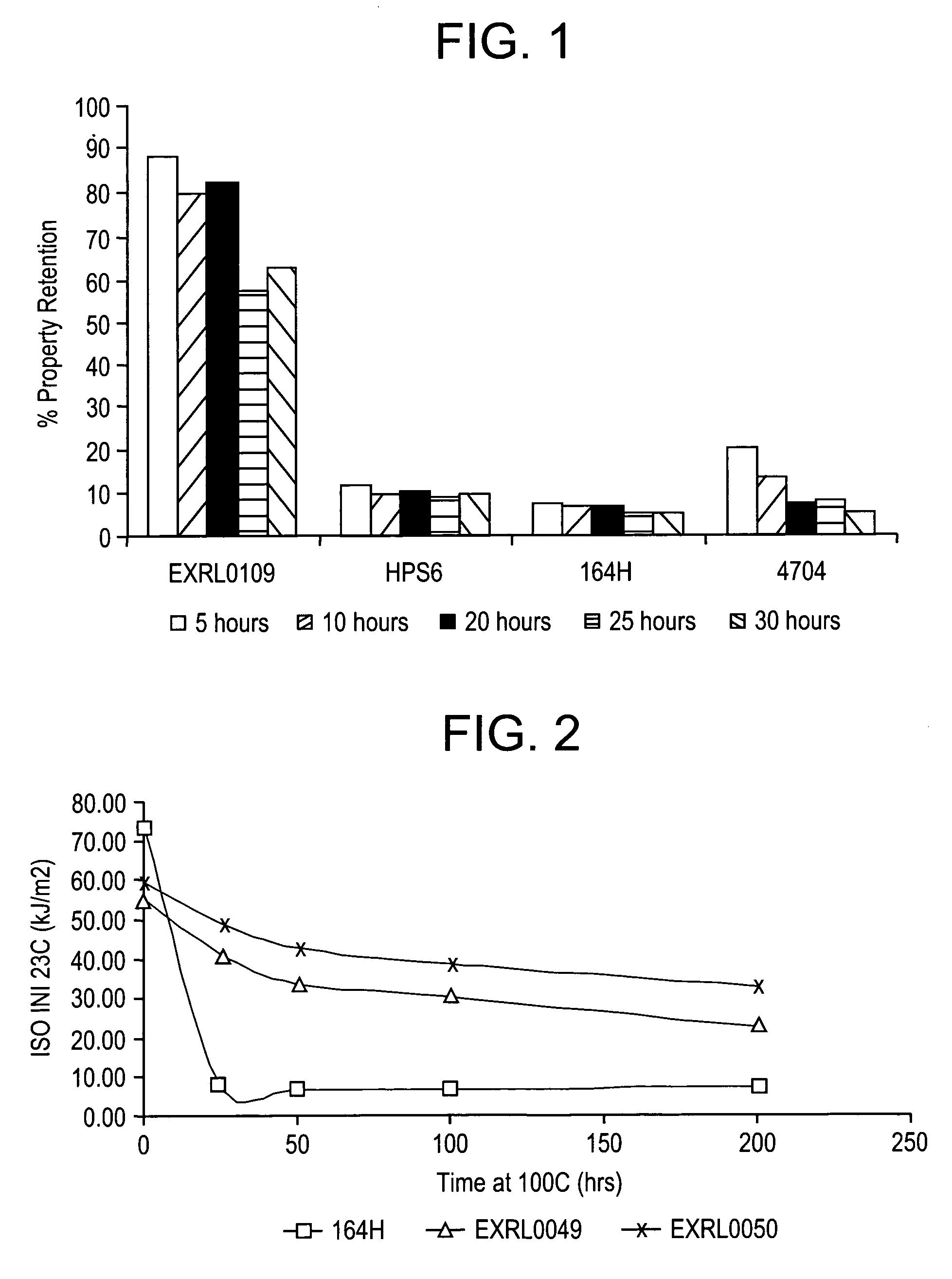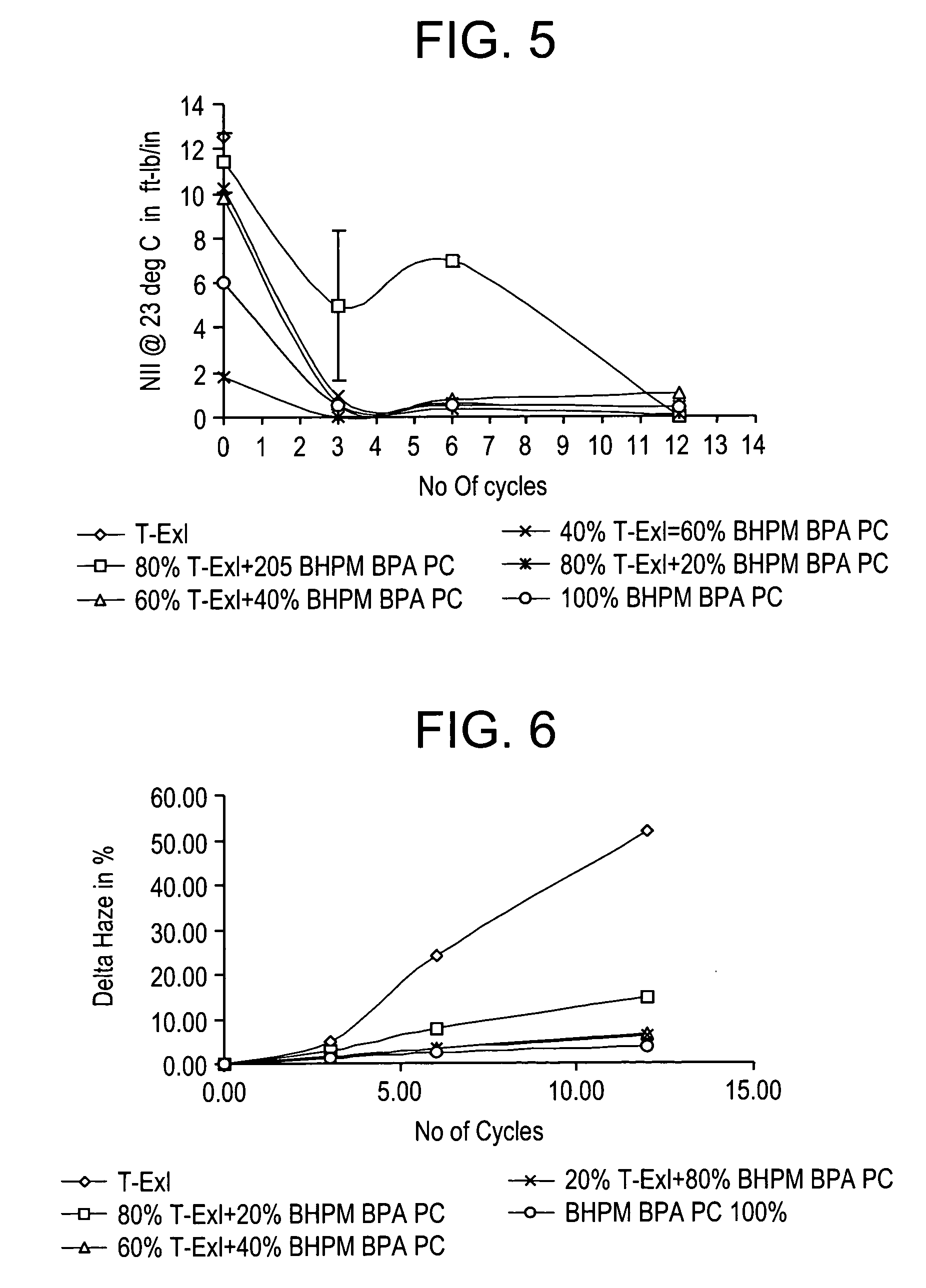Methods of sterilizing polycarbonate articles and methods of manufacture
a technology of polyetherimide and polycarbonate, which is applied in the field of polyetherimide articles, can solve the problems of low impact strength, color of polyetherimide, and degradation of the advantageous physical and/or mechanical properties of polycarbonate,
- Summary
- Abstract
- Description
- Claims
- Application Information
AI Technical Summary
Benefits of technology
Problems solved by technology
Method used
Image
Examples
examples
[0117] The following materials were used in the Examples below: [0118] A: Polycarbonate-polysiloxane copolymer; 3.5 wt. % polydimethylsiloxane, wherein D=45-50. [0119] B: Polycarbonate-polysiloxane copolymer; 5.0 wt. % polydimethylsiloxane wherein D=45-50. [0120] B1: ISO 10993-tested polysiloxane-polycarbonate; 3.5 wt. % polysiloxane, wherein D=45-50. [0121] LEXAN 141: Multi-purpose, medium viscosity BPA polycarbonate [0122] LEXAN 164H: Polycarbonate product with improved hydrolytic stability [0123] HPS6: High viscosity, high molecular weight polycarbonate [0124] 4704: High temperature polyphthalyl-BPA carbonate copolymer. Example 1
[0125] Samples of the above polymers were molded into ASTM bars of 0.125-inch (3.2 mm) thickness. The initial notched Izod impact strength was measured in accordance with ASTM D256. The samples were then placed into a saturated steam autoclave, and the autoclave was maintained at 121° C. (250° F.) for the indicated amount of time. The samples were remove...
example 2
[0127] Samples were molded into ISO Izod bars and notched. The initial notched Izod impact strength was measured. The samples were then placed into a saturated steam autoclave, and the autoclave was maintained at 100° C. (212° F.) for the indicated amount of time. The samples were removed and the notched Izod impact strength of the autoclaved samples was measured. Data are reported as percent retention of the initial notched Izod impact strength. In all cases, five bars of each sample were measured.
[0128] Table 2 shown the retention of notched Izod impact strength in kilojoules per square meter (kJ / m2) for polysiloxane-polycarbonate products vs. polycarbonate products. MVR, as used in all of the examples, is the melt viscosity rate expressed in cm3 / 10 min measured according to ISO 1133. Notched Izod impact strength is given in kJ / m2 according to ISO 180 / 1A.
TABLE 2164H(0%ABCompositionPDMS)(5% PDMS)(3.5% PDMS)Melt viscosity rate (ISO 1133)MVR 300° C. / 1.2cm3 / 10 min9.118.18.25kg-AvgM...
example 3
[0132] In Example 3 the samples were molded into ASTM Izod bars of 0.125-inch (3.2 mm) thickness. The initial notched Izod impact strength was measured. The samples were then placed into a saturated steam autoclave, and the autoclave was maintained at 121° C. (250° F.) for the indicated amount of time. The samples were removed, notched, and the notched Izod impact strength of the autoclaved samples was measured. Data are reported as percent retention of the initial notched Izod impact strength. In all cases, five bars of each sample were measured.
[0133] Table 4 shows the improvement of Notched Izod Impact (ft-lb / in) retention after autoclaving at 121° C. and 1.5 atmospheres by increasing polysiloxane-polycarbonate content.
TABLE 4Composition4504EXL IEXL IIEXL III% polyphthalyl carbonate60606060% polycarbonate4020200% polysiloxane-0202040polycarbonateMelt Flow Rate (g / cm3)3.064.023.353.77HDT (° C., 1.8 Mpa)142.0140.8141.2137.9Notched Izod Impact (ft-lb / in, ASTM D256) 0 hr - Avg11.4...
PUM
| Property | Measurement | Unit |
|---|---|---|
| temperature | aaaaa | aaaaa |
| wt. % | aaaaa | aaaaa |
| heat deflection temperature | aaaaa | aaaaa |
Abstract
Description
Claims
Application Information
 Login to View More
Login to View More - R&D
- Intellectual Property
- Life Sciences
- Materials
- Tech Scout
- Unparalleled Data Quality
- Higher Quality Content
- 60% Fewer Hallucinations
Browse by: Latest US Patents, China's latest patents, Technical Efficacy Thesaurus, Application Domain, Technology Topic, Popular Technical Reports.
© 2025 PatSnap. All rights reserved.Legal|Privacy policy|Modern Slavery Act Transparency Statement|Sitemap|About US| Contact US: help@patsnap.com



